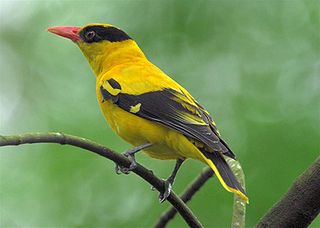
Orioles are colourful Old World passerine birds in the genus Oriolus, the type genus of the corvoidean family Oriolidae. They are not closely related to the New World orioles, which are icterids that belong to the superfamily Passeroidea.

Icterids or New World blackbirds make up a family, the Icteridae, of small to medium-sized, often colorful, New World passerine birds. The family contains 108 species and is divided into 30 genera. Most species have black as a predominant plumage color, often enlivened by yellow, orange, or red. The species in the family vary widely in size, shape, behavior, and coloration. The name, meaning "jaundiced ones" comes from the Ancient Greek ikteros via the Latin ictericus. This group includes the New World blackbirds, New World orioles, the bobolink, meadowlarks, grackles, cowbirds, oropendolas, and caciques.

The New World warblers or wood-warblers are a group of small, often colorful, passerine birds that make up the family Parulidae and are restricted to the New World. The family contains 120 species. They are not closely related to Old World warblers or Australian warblers. Most are arboreal, but some, like the ovenbird and the two waterthrushes, are primarily terrestrial. Most members of this family are insectivores.

The avian genus Quiscalus contains seven of the 11 species of grackles, gregarious passerine birds in the icterid family. They are native to North and South America.

Cowbirds are birds belonging to the genus Molothrus in the family Icteridae. They are of New World origin, and are obligate brood parasites, laying their eggs in the nests of other species.
Meadowlarks are New World grassland birds belonging to genera Sturnella and Leistes.

The giant cowbird is a large passerine bird in the New World family Icteridae. It breeds from southern Mexico south to northern Argentina, and on Trinidad and Tobago. It may have relatively recently colonised the latter island. It is a brood parasite and lays its eggs in the nests of other birds.

Oropendolas are a genus of passerine birds, Psarocolius, in the New World blackbird family Icteridae. They were formerly split among two or three different genera and are found in Central and South America.

The caciques are passerine birds in the New World blackbird family which are resident breeders in tropical South America north to Mexico. All of the group are in currently placed in the genus Cacicus, except the aberrant yellow-billed cacique, and the Mexican cacique which constitute respective monotypic genera. Judging from mitochondrial DNA cytochrome b and NADH dehydrogenase subunit 2 sequence, the aberrant oropendolas band-tailed oropendola and casqued oropendola, Psarocolius oseryi seem to be closer to the caciques.

Agelasticus is a genus of birds in the New World oriole family Icteridae. They have slender forms and thin bills. The females are responsible for building the nest, unlike some of their close relatives. The genus is found in South America.
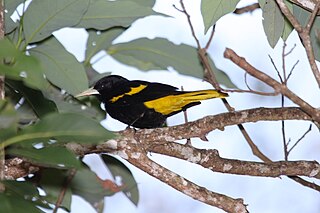
The Mexican cacique or yellow-winged cacique is a species of cacique in the family Icteridae. It is found only on the west coast of Mexico and the northernmost edge of Guatemala. It is monotypic in its own genus.

Chrysomus is a genus of bird in the family Icteridae. Established by William John Swainson in 1837, it contains the following species:

The Cuban blackbird is a species of bird in the family Icteridae.

The chopi blackbird is a species of bird in the family Icteridae. It is monotypic within the genus Gnorimopsar. It is found in Argentina, Bolivia, Brazil, Paraguay, Peru, and Uruguay. Its natural habitats are dry savanna, subtropical or tropical seasonally wet or flooded lowland grassland, pastureland, and heavily degraded former forest.

Macroagelaius is a genus of bird in the family Icteridae. It contains the following species:
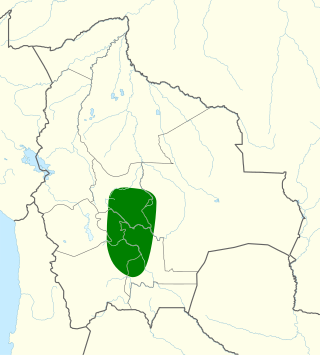
The Bolivian blackbird is a species of bird in the family Icteridae. It is monotypic within the genus Oreopsar.
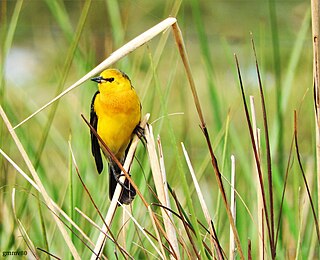
The saffron-cowled blackbird is a species of bird in the family Icteridae. It is the only species placed in the genus Xanthopsar. It has bright yellow underparts and black or dark brown upperparts. It is found in Argentina, Brazil, Paraguay, and in Uruguay at the Quebrada de los Cuervos. Its natural habitats are subtropical or tropical dry lowland grassland, subtropical or tropical seasonally wet or flooded lowland grassland, and pastureland. It is threatened by habitat loss.
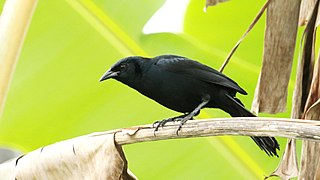
Dives is a genus of two Neotropical birds in the family Icteridae.

Rhinonyssidae is a family of mites in the order Mesostigmata. There are about 16 genera and at least 460 described species in Rhinonyssidae.

The baywings are two species of birds in the genus Agelaioides, which were described in the early 19th century. These species are found in Brazil and in the case of A. badius, also Argentina, Bolivia, Uruguay, and Paraguay. They were formerly in included in genus Molothrus with cowbirds.





















